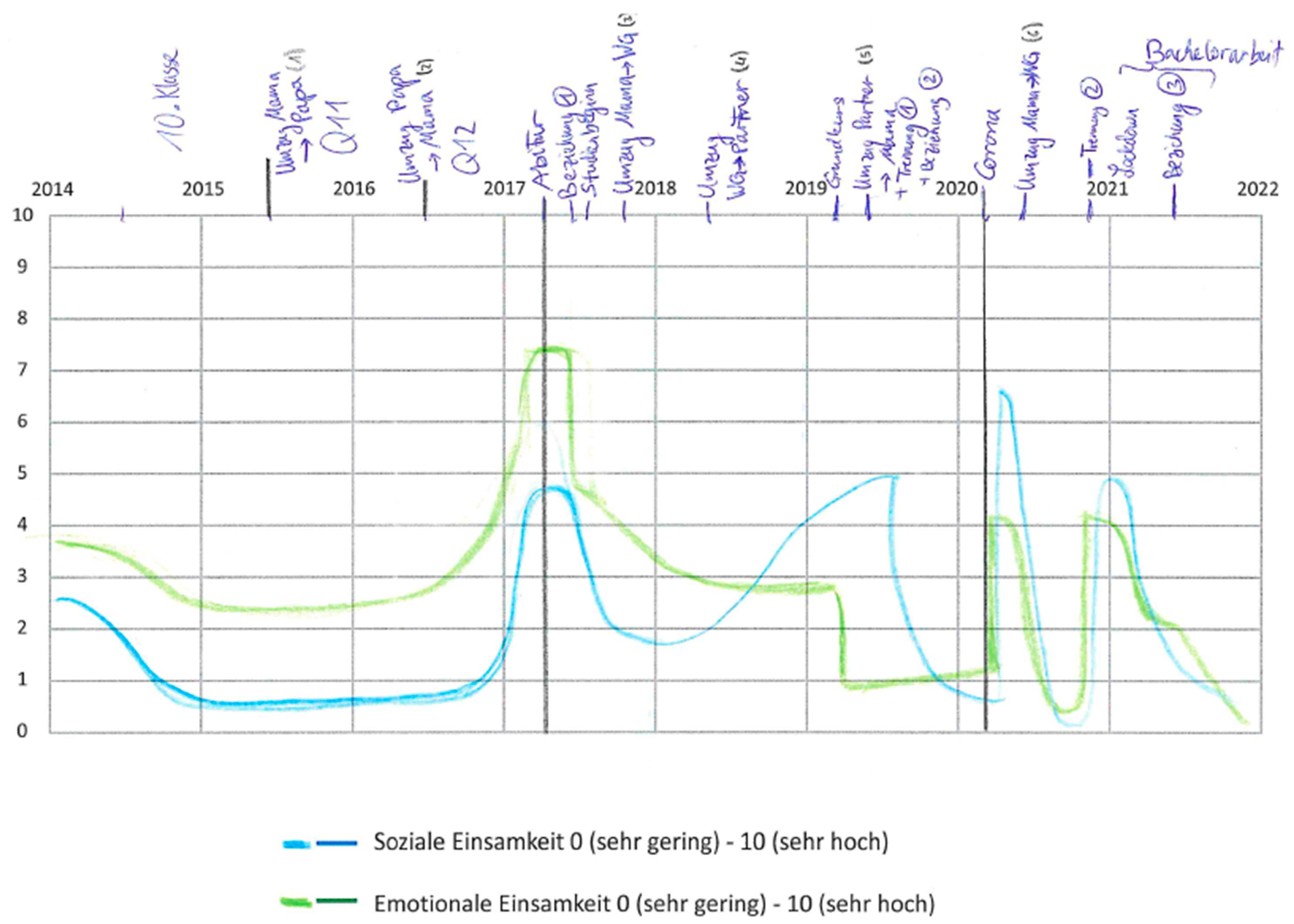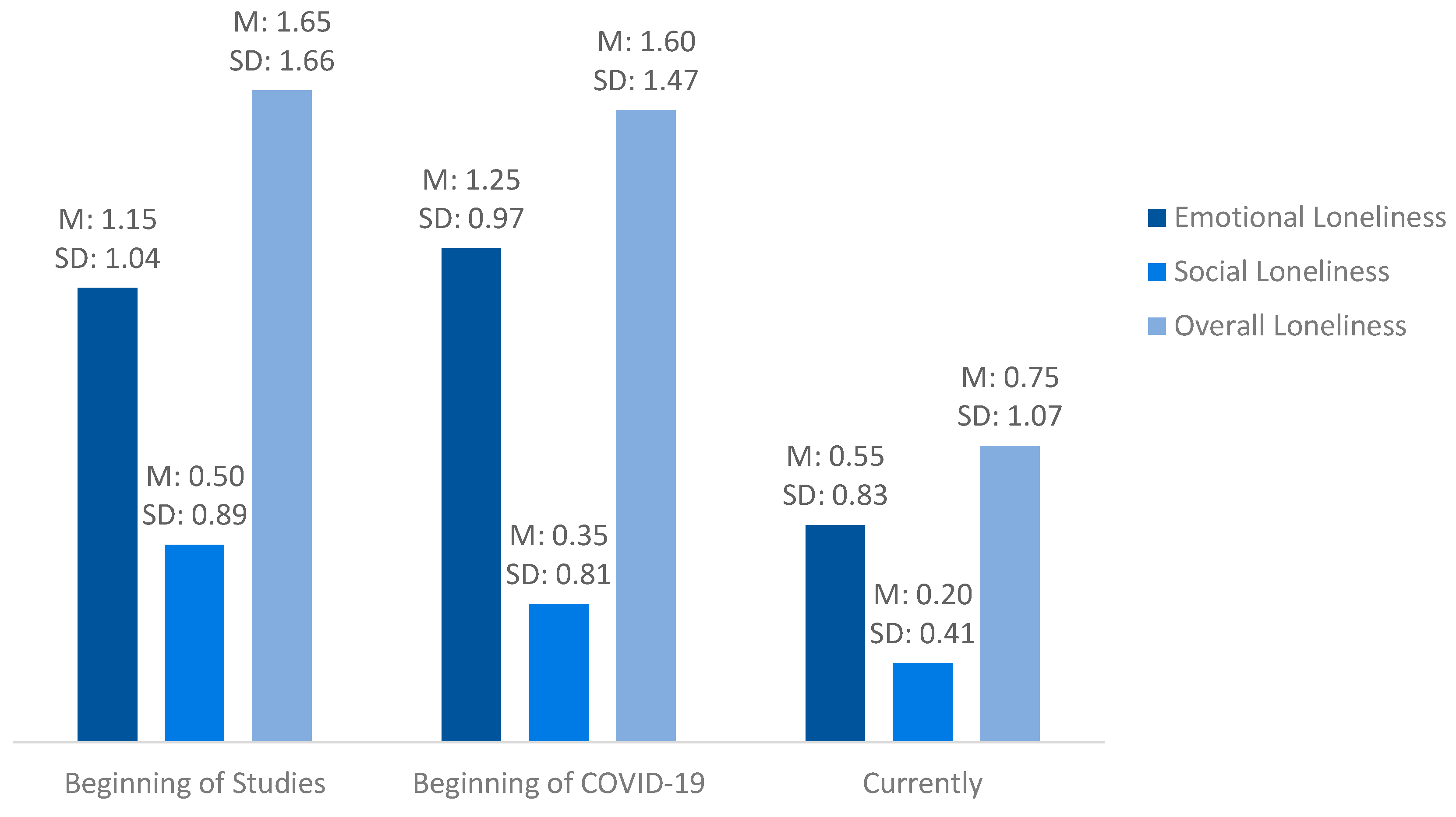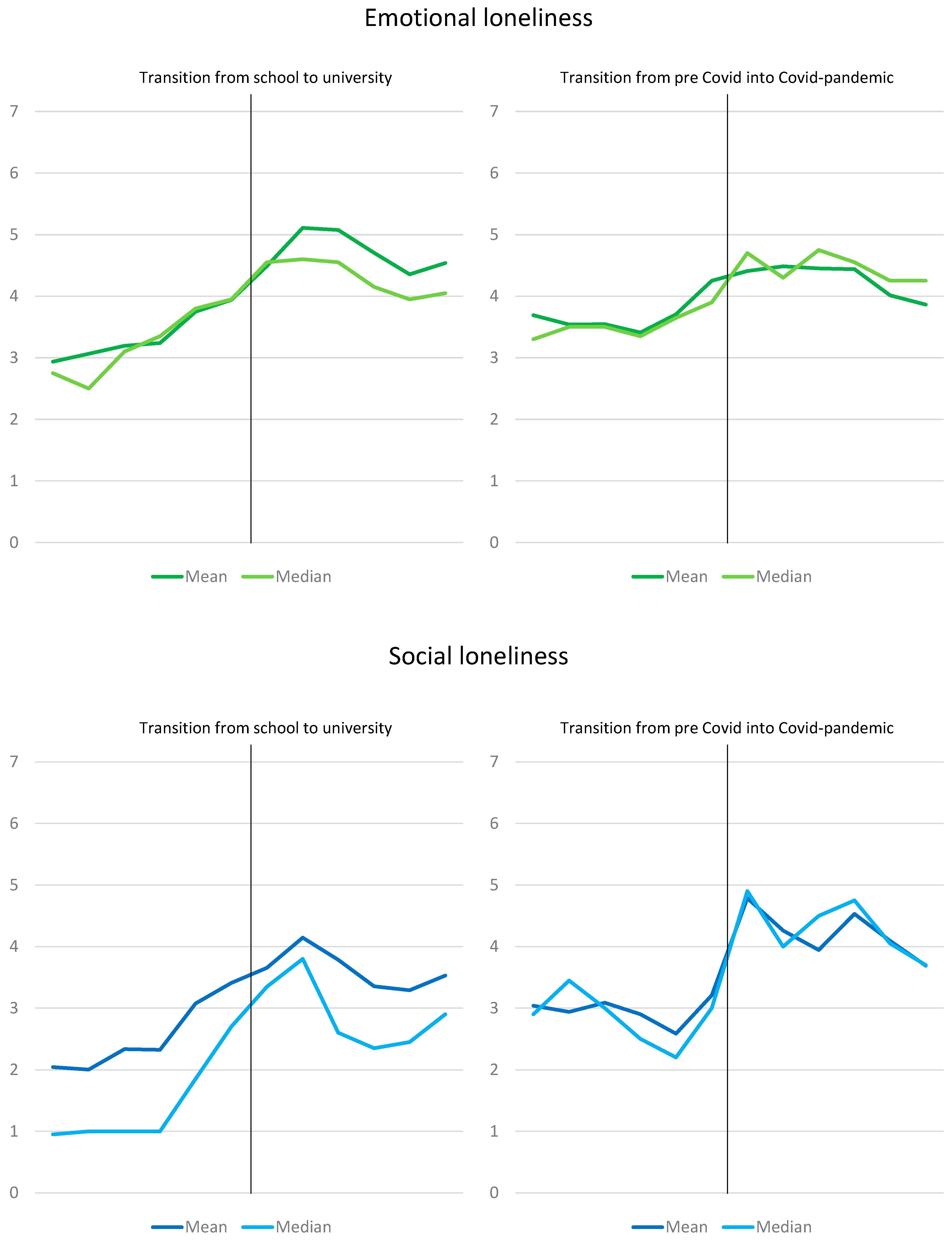Loneliness in University Students during Two Transitions: A Mixed Methods Approach Including Biographical Mapping
Abstract
:1. Introduction
2. Materials and Methods
2.1. Study Population
2.2. Measures
2.2.1. Quantitative Component
- I experience a general sense of emptiness.
- I miss having people around.
- I often feel rejected.
- There are plenty of people I can rely on when I have problems.
- There are many people I can trust completely.
- There are enough people I feel close to.
2.2.2. Qualitative Data
2.2.3. Biographical Mapping
2.3. Data Analysis
3. Results
3.1. Quantitative Component
3.2. Biographical Mapping
3.3. Qualtiative Findings
3.3.1. Students’ General View of Loneliness
3.3.2. Loneliness and the Transition from High School to University
3.3.3. Change of Residence at the Start of Study and the Association with Loneliness
3.3.4. Loneliness during the Transition into the COVID-19 Pandemic
3.3.5. Attempts to Overcome Loneliness during the COVID-19 Pandemic
3.4. Synopsis
4. Discussion
4.1. Transition from High School to University
4.2. Transition into the COVID-19 Pandemic
4.3. Limitations
5. Conclusions
Author Contributions
Funding
Institutional Review Board Statement
Informed Consent Statement
Data Availability Statement
Conflicts of Interest
References
- Cacioppo, J.T.; Hawkley, L.C.; Crawford, L.E.; Ernst, J.M.; Burleson, M.H.; Kowalewski, R.B.; Malarkey, W.B.; Van Cauter, E.; Berntson, G.G. Loneliness and health: Potential mechanisms. Psychosom. Med. 2002, 64, 407–417. [Google Scholar] [CrossRef]
- Leigh-Hunt, N.; Bagguley, D.; Bash, K.; Turner, V.; Turnbull, S.; Valtorta, N.; Caan, W. An overview of systematic reviews on the public health consequences of social isolation and loneliness. Public Health 2017, 152, 157–171. [Google Scholar] [CrossRef]
- Richardson, T.; Elliott, P.; Roberts, R. Relationship between loneliness and mental health in students. J. Public Ment. Health 2017, 16, 48–54. [Google Scholar] [CrossRef]
- Fakoya, O.A.; McCorry, N.K.; Donnelly, M. Loneliness and social isolation interventions for older adults: A scoping review of reviews. BMC Public Health 2020, 20, 129. [Google Scholar] [CrossRef]
- Luanaigh, C.O.; Lawlor, B.A. Loneliness and the health of older people. Int. J. Geriatr. Psychiatry 2008, 23, 1213–1221. [Google Scholar] [CrossRef]
- Malcolm, M.; Frost, H.; Cowie, J. Loneliness and social isolation causal association with health-related lifestyle risk in older adults: A systematic review and meta-analysis protocol. Syst. Rev. 2019, 8, 48. [Google Scholar] [CrossRef] [PubMed]
- Bauer, N.; Rokach, A. The Experience of Loneliness in University: A Cross-Cultural Study. Int. J. Adolesc. Youth 2004, 11, 283–302. [Google Scholar] [CrossRef]
- Bernardon, S.; Babb, K.; Hakim-Larson, J.; Gragg, M. Loneliness, Attachment, and the Perception and Use of Social Support in University Students. Can. J. Behav. Sci./Rev. Can. Des Sci. Du Comport. 2011, 43, 40–51. [Google Scholar] [CrossRef]
- Bozoglan, B.; Demirer, V.; Sahin, I. Loneliness, self-esteem, and life satisfaction as predictors of Internet addiction: A cross-sectional study among Turkish university students. Scand J. Psychol. 2013, 54, 313–319. [Google Scholar] [CrossRef]
- Bu, F.; Steptoe, A.; Fancourt, D. Who is lonely in lockdown? Cross-cohort analyses of predictors of loneliness before and during the COVID-19 pandemic. Public Health 2020, 186, 31–34. [Google Scholar] [CrossRef] [PubMed]
- Diehl, K.; Jansen, C.; Ishchanova, K.; Hilger-Kolb, J. Loneliness at Universities: Determinants of Emotional and Social Loneliness among Students. Int. J. Environ. Res. Public Health 2018, 15, 1865. [Google Scholar] [CrossRef]
- Le Roux, A.; Connors, J. A Cross-Cultural Study into Loneliness Amongst University Students. S. Afr. J. Psychol. 2001, 31, 46–52. [Google Scholar] [CrossRef]
- Reuter, M.; Herke, M.; Richter, M.; Diehl, K.; Hoffmann, S.; Pischke, C.R.; Dragano, N. Young people’s health and well-being during the school-to-work transition: A prospective cohort study comparing post-secondary pathways. BMC Public Health 2022, 22, 1823. [Google Scholar] [CrossRef] [PubMed]
- Wójcik, G.; Zawisza, K.; Jabłońska, K.; Grodzicki, T.; Tobiasz-Adamczyk, B. Transition out of Marriage and its Effects on Health and Health–Related Quality of Life among Females and Males. COURAGE and COURAGE-POLFUS–Population Based Follow-Up Study in Poland. Appl. Res. Qual. Life 2021, 16, 13–49. [Google Scholar] [CrossRef]
- Diehl, K.; Hilger, J. Nutrition and physical activity during the transition from adolescence to adulthood: Further research is warranted. Int. J. Adolesc. Med. Health 2015, 27, 101–104. [Google Scholar] [CrossRef] [PubMed]
- Diehl, K.; Lindenthal, J. Trajectories of Health Status during the Transition from School to University: Piloting the Method of Biographical Mapping in German Medical Students. Children 2021, 8, 622. [Google Scholar] [CrossRef] [PubMed]
- Holt-Lunstad, J.; Smith, T.B.; Baker, M.; Harris, T.; Stephenson, D. Loneliness and social isolation as risk factors for mortality: A meta-analytic review. Perspect Psychol. Sci. 2015, 10, 227–237. [Google Scholar] [CrossRef] [PubMed]
- Kroshus, E.; Hawrilenko, M.; Browning, A. Stress, self-compassion, and well-being during the transition to college. Soc. Sci. Med. 2021, 269, 113514. [Google Scholar] [CrossRef]
- Fiorenzato, E.; Cona, G. One-year into COVID-19 pandemic: Decision-making and mental-health outcomes and their risk factors. J. Affect Disord. 2022, 309, 418–427. [Google Scholar] [CrossRef]
- Killgore, W.D.S.; Cloonan, S.A.; Taylor, E.C.; Dailey, N.S. Loneliness: A signature mental health concern in the era of COVID-19. Psychiatry Res. 2020, 290, 113117. [Google Scholar] [CrossRef] [PubMed]
- Kohls, E.; Baldofski, S.; Moeller, R.; Klemm, S.L.; Rummel-Kluge, C. Mental Health, Social and Emotional Well-Being, and Perceived Burdens of University Students During COVID-19 Pandemic Lockdown in Germany. Front. Psychiatry 2021, 12, 643957. [Google Scholar] [CrossRef] [PubMed]
- Son, C.; Hegde, S.; Smith, A.; Wang, X.; Sasangohar, F. Effects of COVID-19 on College Students’ Mental Health in the United States: Interview Survey Study. J. Med. Internet Res. 2020, 22, e21279. [Google Scholar] [CrossRef] [PubMed]
- Weber, M.; Schulze, L.; Bolzenkötter, T.; Niemeyer, H.; Renneberg, B. Mental Health and Loneliness in University Students During the COVID-19 Pandemic in Germany: A Longitudinal Study. Front. Psychiatry 2022, 13, 848645. [Google Scholar] [CrossRef]
- Werner, A.M.; Tibubos, A.N.; Mülder, L.M.; Reichel, J.L.; Schäfer, M.; Heller, S.; Pfirrmann, D.; Edelmann, D.; Dietz, P.; Rigotti, T.; et al. The impact of lockdown stress and loneliness during the COVID-19 pandemic on mental health among university students in Germany. Sci. Rep. 2021, 11, 22637. [Google Scholar] [CrossRef] [PubMed]
- Weiss, R.S.; Bowlby, J. Loneliness: The Experience of Emotional and Social Isolation; MIT Press: Cambridge, MA, USA, 1980. [Google Scholar]
- De Jong Gierveld, J.; Tilburg, T.V. A 6-Item Scale for Overall, Emotional, and Social Loneliness. Res. Aging 2006, 28, 582–598. [Google Scholar] [CrossRef]
- De Jong Gierveld, J.; Van Tilburg, T. The De Jong Gierveld short scales for emotional and social loneliness: Tested on data from 7 countries in the UN generations and gender surveys. Eur. J. Ageing 2010, 7, 121–130. [Google Scholar] [CrossRef] [PubMed]
- Mayring, P. Qualitative Inhaltsanalyse: Grundlagen und Techniken; Beltz: Weinheim, Germany, 2015. [Google Scholar]
- Hysing, M.; Petrie, K.; Bøe, T.; Lønning, K.; Sivertsen, B. Only the Lonely: A Study of Loneliness Among University Students in Norway. Clin. Psychol. Eur. 2020, 2, 1–6. [Google Scholar] [CrossRef]
- Hicks, T.; Heastie, S. High school to college transition: A profile of the stressors, physical and psychological health issues that affect the first-year on-campus college student. J. Cult. Divers 2008, 15, 143–147. [Google Scholar]
- Picton, A.; Greenfield, S.; Parry, J. Why do students struggle in their first year of medical school? A qualitative study of student voices. BMC Med. Educ. 2022, 22, 100. [Google Scholar] [CrossRef]
- Bruffaerts, R.; Mortier, P.; Kiekens, G.; Auerbach, R.P.; Cuijpers, P.; Demyttenaere, K.; Green, J.G.; Nock, M.K.; Kessler, R.C. Mental health problems in college freshmen: Prevalence and academic functioning. J. Affect Disord. 2018, 225, 97–103. [Google Scholar] [CrossRef]
- Prati, G.; Mancini, A.D. The psychological impact of COVID-19 pandemic lockdowns: A review and meta-analysis of longitudinal studies and natural experiments. Psychol. Med. 2021, 51, 201–211. [Google Scholar] [CrossRef]
- Niedzwiedz, C.L.; Green, M.J.; Benzeval, M.; Campbell, D.; Craig, P.; Demou, E.; Leyland, A.; Pearce, A.; Thomson, R.; Whitley, E.; et al. Mental health and health behaviours before and during the initial phase of the COVID-19 lockdown: Longitudinal analyses of the UK Household Longitudinal Study. J. Epidemiol. Community Health 2021, 75, 224–231. [Google Scholar] [CrossRef] [PubMed]
- Benke, C.; Autenrieth, L.K.; Asselmann, E.; Pané-Farré, C.A. Lockdown, quarantine measures, and social distancing: Associations with depression, anxiety and distress at the beginning of the COVID-19 pandemic among adults from Germany. Psychiatry Res. 2020, 293, 113462. [Google Scholar] [CrossRef] [PubMed]
- Birmingham, W.C.; Wadsworth, L.L.; Lassetter, J.H.; Graff, T.C.; Lauren, E.; Hung, M. COVID-19 lockdown: Impact on college students’ lives. J. Am. Coll Health 2021, 1–15. [Google Scholar] [CrossRef] [PubMed]
- Matos Fialho, P.M.; Spatafora, F.; Kühne, L.; Busse, H.; Helmer, S.M.; Zeeb, H.; Stock, C.; Wendt, C.; Pischke, C.R. Perceptions of Study Conditions and Depressive Symptoms during the COVID-19 Pandemic Among University Students in Germany: Results of the International COVID-19 Student Well-Being Study. Front. Public Health 2021, 9, 674665. [Google Scholar] [CrossRef]
- Weiss, E.; Kaufmann, L.; Ninaus, M.; Canazei, M. Belastungen durch Fernlehre und psychische Gesundheit von Studierenden während der COVID-19-Pandemie [The Impact of Distance Learning during COVID-19 on Mental Health in Students]. Lern. Und Lernstörungen 2022, 11, 167–179. [Google Scholar] [CrossRef]
- Becker, K.; Lörz, M. Studieren während der Corona-Pandemie: Die finanzielle Situation von Studierenden und mögliche Auswirkungen auf das Studium. DZHW Brief. 2020, 9, 2020. [Google Scholar] [CrossRef]
- Negash, S.; Kartschmit, N.; Mikolajczyk, R.T.; Watzke, S.; Matos Fialho, P.M.; Pischke, C.R.; Busse, H.; Helmer, S.M.; Stock, C.; Zeeb, H.; et al. Worsened Financial Situation During the COVID-19 Pandemic Was Associated with Depressive Symptomatology among University Students in Germany: Results of the COVID-19 International Student Well-Being Study. Front. Psychiatry 2021, 12, 743158. [Google Scholar] [CrossRef]



| ID | Age of Participant, y | Sex of Participant | Change of Residence for Study | Number of Semesters in Current Program | Program Type | Participation in Extracurricular Activities | Current Housing Situation | Current Relationship Status |
|---|---|---|---|---|---|---|---|---|
| P01 | 23 | Female | Yes | 3 | Master’s | Yes | shared apartment | in a relationship |
| P02 | 26 | Male | Yes | 9 | State Examination | Yes | shared apartment | single |
| P03 | 26 | Male | No | 3 | Master’s | Yes | shared apartment | single |
| P04 | 23 | Male | Yes | 7 | Bachelor’s | Yes | shared apartment | in a relationship |
| P05 | 25 | Female | Yes | 1 | Bachelor’s | Yes | shared apartment | single |
| P06 | 24 | Male | Yes | 3 | Master’s | Yes | shared apartment | in a relationship |
| P07 | 24 | Female | No | 1 | Master’s | Yes | living with parents | in a relationship |
| P08 | 24 | Male | Yes | 6 | Master’s | Yes | shared apartment | in a relationship |
| P09 | 21 | Female | Yes | 1 | Master’s | Yes | shared apartment | in a relationship |
| P10 | 25 | Male | Yes | 3 | Master’s | Yes | shared apartment | single |
| P11 | 22 | Female | Yes | 1 | Master’s | Yes | shared apartment | in a relationship |
| P12 | 24 | Female | Yes | 3 | Master’s | Yes | shared apartment | in a relationship |
| P13 | 27 | Female | Yes | 3 | Master’s | Yes | single apartment | single |
| P14 | 26 | Female | No | 3 | Master’s | Yes | shared apartment | single |
| P15 | 23 | Female | Yes | 4 | Master’s | Yes | single apartment | single |
| P16 | 22 | Female | No | 5 | Bachelor’s | Yes | shared apartment | in a relationship |
| P17 | 27 | Female | Yes | 4 | Master’s | No | living with partner | in a relationship |
| P18 | 23 | Male | No | 5 | Master’s | No | shared apartment | single |
| P19 | 24 | Female | Yes | 3 | Master’s | Yes | shared apartment | in a relationship |
| P20 | 23 | Male | Yes | 3 | Bachelor’s | No | dormitory | in a relationship |
Disclaimer/Publisher’s Note: The statements, opinions and data contained in all publications are solely those of the individual author(s) and contributor(s) and not of MDPI and/or the editor(s). MDPI and/or the editor(s) disclaim responsibility for any injury to people or property resulting from any ideas, methods, instructions or products referred to in the content. |
© 2023 by the authors. Licensee MDPI, Basel, Switzerland. This article is an open access article distributed under the terms and conditions of the Creative Commons Attribution (CC BY) license (https://creativecommons.org/licenses/by/4.0/).
Share and Cite
Jaud, J.; Görig, T.; Konkel, T.; Diehl, K. Loneliness in University Students during Two Transitions: A Mixed Methods Approach Including Biographical Mapping. Int. J. Environ. Res. Public Health 2023, 20, 3334. https://doi.org/10.3390/ijerph20043334
Jaud J, Görig T, Konkel T, Diehl K. Loneliness in University Students during Two Transitions: A Mixed Methods Approach Including Biographical Mapping. International Journal of Environmental Research and Public Health. 2023; 20(4):3334. https://doi.org/10.3390/ijerph20043334
Chicago/Turabian StyleJaud, Janna, Tatiana Görig, Tobias Konkel, and Katharina Diehl. 2023. "Loneliness in University Students during Two Transitions: A Mixed Methods Approach Including Biographical Mapping" International Journal of Environmental Research and Public Health 20, no. 4: 3334. https://doi.org/10.3390/ijerph20043334
APA StyleJaud, J., Görig, T., Konkel, T., & Diehl, K. (2023). Loneliness in University Students during Two Transitions: A Mixed Methods Approach Including Biographical Mapping. International Journal of Environmental Research and Public Health, 20(4), 3334. https://doi.org/10.3390/ijerph20043334






